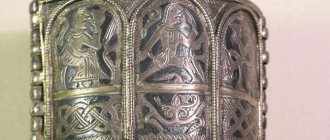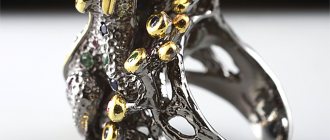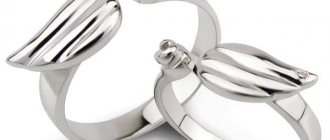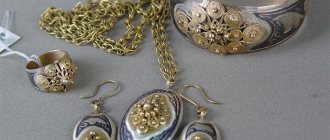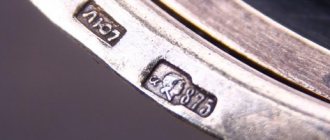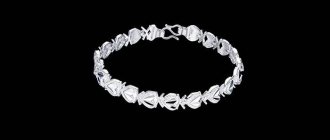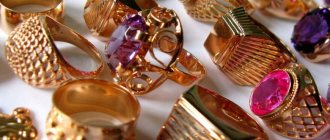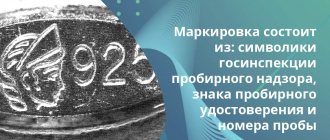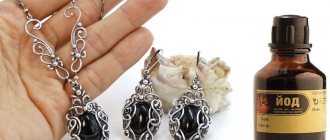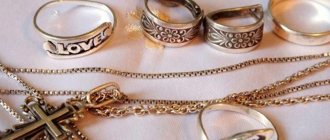Post updated: Oct 9, 2020
875 silver was in great demand during the Soviet era, and now many families have preserved grandmothers’ jewelry, which is visually very similar to platinum jewelry. It's all about the impurities that give the metal its special color. The mark 875 belongs to the list of standard samples of the metric system of assaying precious metals, which was introduced on the territory of the USSR in 1927, and continues to operate on the territory of modern Russia to the present day.
Composition and properties of silver alloy with 875 purity
The number 875 means that per 1000 g of alloy there are 875 g of pure silver and 125 g of various impurities.
Soviet 875 silver has established itself as an example of quality, so products produced during the Soviet era, when standards were strictly adhered to, are valued much higher than products with modern markings.
Nowadays, most often, copper is used as an alloy, which gives the product strength, but also a yellowish tint. Aluminum, nickel, and cadmium can also be used as impurities. Each of the additives directly affects the color and physical properties of the resulting alloy. Some production options may have used platinum and palladium. Interestingly, nickel and platinum give the alloy a color that cannot be distinguished from the color of white gold, which unscrupulous sellers can take advantage of by offering to purchase an 875 gold item.
What is a sample?
People who are far from jewelry making are not familiar with the meaning of the word “sample.” We may wear gold jewelry marked 999 and know that this is a sign of the highest quality of the yellow metal, but not know why. So, this is the metal content of the jewelry. The gold chain with the hallmark 750 contains 75% aurum, the silver necklace contains 960–96% argentum. The remaining share comes from other metals, since most of the jewelry on the jewelry counter is alloys. These metals give the product special properties:
- ductility;
- desired shade;
- strength;
- elasticity.
A mark indicating the precious metal content is always applied to the surface of the jewelry.
875 silver hallmarks and their meanings
For 10 years after the overthrow of the imperial regime until 1927. There were no standards for hallmarking precious metals. Beginning in 1927, the first mark, with the introduction of the metric testing system, was the image of a worker’s head at the ready with a hammer, combined with an alphabetic code (state inspection) and the number of the corresponding sample. Later they added a code for the year of manufacture of the product.
From May 1958, the worker's head was replaced by a five-pointed star with a hammer and sickle in the center. This mark was used until 1994.
In modern Russia, since 1994, a stamp has been affixed with the image of a female head in a kokoshnik, looking to the right.
An 84 hallmark on silver means that the item was made before 1917 and is likely to have high value among antique dealers and collectors. This sign belonged to the spool system, operating in the Russian Empire from the end of the 18th century to 1927. A more accurate age of an object can be determined from the image, which was affixed along with the metal sample numbers.
What is 875 sample with a star?
Each state uses its own labeling system, approved by the relevant control body. The appearance of the mark differs depending on the country that issued it.
Silver products made in Russia are marked with various types of hallmarks. It depends on the period of manufacture of the silver alloy:
- issued from 1958 to 1994 - marked with a stamp with a symbolic design of a five-pointed star containing a hammer and sickle;
- after 1994 - marked with a profile picture of the girl.
875 silver from the Soviet period (it has a star) is the most valuable. It is not currently produced, which already increases the value, and the image indicates the authenticity of the alloy: in the USSR there were no imported metals with a lower content of the main element. For these reasons, the cost per gram of metal with a star is higher than for products with a kokoshnik.
875 silver hallmark with head
The hallmark of 875 silver with the head of a woman in a kokoshnik turned to the right has been affixed since 1994. A similar image was used to mark 84-karat royal silver in the spool system. In addition to the female image, various forms of hallmarks are used to brand different precious metals.
For silver, it is an oval with cut off sides, into which the profile of a woman is inscribed - the sign of the assay certificate, numbers - the designation of the metal standard and the letter - the code of the state inspection of the assay supervision.
And this is what a silver stamp with a worker’s head looks like from 1927 to 1958.
Nomenclature of gold and silver samples
The Assay Supervision of the Russian Federation has developed a system of impressions for different types of precious metals. For example, for gold a stamp of a special shape is used - an elongated rectangle with a certain set of numbers, characteristic only for gold: 333, 375, 500, 585, 750, 958, 999.
For silver, the following numerical indicators are used: 800, 830, 875, 925, 960. The exception is the 999 sample, which also indicates the almost complete absence of other impurities. So we got the answer to this fairly common question: “875 standard: what kind of metal is this?”
What does the mark mean?
A hallmark is a state guarantor that confirms the presence of a certain proportion of the most valuable metal in an alloy. If you can read the mark on a piece of jewelry, you can learn more about its history and making.
In Russian jewelry production, a branding system with 3 elements is used:
- a three-digit code indicating the letters of the state inspection inspectorate (8 cm): it contains the year of manufacture, the inspection inspection code and the manufacturer’s code;
- hallmark mark: for products of the Soviet period - a five-pointed star, in modern Russia - a female profile with a kokoshnik;
- license plate.
How to choose?
When buying a precious metal, you first need to determine the purpose of this action.
Following several rules will help you make the right choice:
- It is better to purchase silver only in official jewelry stores.
- Without leaving the store, you need to check the presence of the hallmark and hallmark.
- Due to the proven harmful effects of zinc, it is better to give preference to models without it.
- The optimal product sample is 925.
- Don't forget to take the receipt.
Transition to the metric assay system
Really major changes occurred in 1927, when Russia switched from the old spool system to the new metric system. At that time, a similar system was already in operation in Germany and soon promised to become an international standard.
Unlike the spool system, which is tied to an exclusively Russian measure of weight - the spool, the metric system allows you to determine the proportion of precious metal in the alloy. For example, a 585-grade alloy contains 585 g of pure precious metal and 415 g of impurities, respectively, per 1000 g of alloy. In this case, the metal sample is indicated on the product with three numbers, and not two, as with the spool system.
The transition to the metric system was not the only new thing in 1927. A new brand appeared, which depicted the head of a worker with a hammer. It is quite natural, given the dramatic political changes in the country and the rise to power of the Soviets.
Is it possible to determine the sample at home?
To determine the sample at home, you will have to arm yourself with a magnifying glass and look for a special marking, that is, a brand. If there is a sample, we can say that we are talking about a noble metal, although today there are often fakes. For this reason, it is worth taking note of several more methods:
- silver does not interact with a magnet, unlike metal, which means that such an examination will immediately identify a fake;
- has high thermal conductivity and heats up easily in the hands;
- darker from exposure to sulfur;
- You can drip iodine onto the product. If a dark-colored spot remains, then the metal is silver;
- the appearance of darkening from chalk indicates that the metal is of the highest standard.
Using these methods, you can independently determine the degree of quality of the product and the metal itself, however, if in doubt, it is better to contact a jeweler who will make an accurate diagnosis.
USSR silver samples, all sample numbers
The Soviet government cared little about hallmarking silver, since the priority goal was to audit precious items and subsequently sell them to other countries, since it was necessary to raise funds for the world revolution. The first actions regarding the normalization of processes in the jewelry business were made a year after the revolution, when control over all processes was entrusted to a commission that was formed under the Council of People's Commissars.
Almost ten years later, silver hallmarking was carried out according to the rules that were introduced under Tsarist Russia. The document was published at the end of the nineteenth century. The purity of silver was determined by the presence of a mark. which looked like a woman's head in a kokoshnik, which is enclosed in shields of various shapes. The shapes were round, rectangular, oval or hammer-shaped. Next to the image was a number indicating the sample, and the initials of the heads of the assay districts were also indicated. In 1908, the marking was changed, and the female profile began to be turned to the right side, and the district was designated in Greek letters.
These marks continued to be used at enterprises that opened after the revolution. In 1918, a platinum plant began operating in the capital, which was created on the basis of the factory named after. Khlebnikov. He was engaged in the production of products intended for enterprises in the chemical and electrical industries, and also dealt in small batches of silver cutlery, namely spoons, forks and cup holders. These products were marked with the “Platinopribor” mark.
In the twenties of the last century, jewelry was made in artisanal jewelry workshops. Their number increased greatly, and the People's Commissariat for Finance allowed the free sale of jewelry. As a result, in 1923, the Moscow Jewelry Partnership was created, which was supposed to control the production and sale of gold and silver items. As a result, for three years all jewelry products were labeled “MYT”.
At the end of the revolution, only three assay offices operated for a long time, which were located in the capital, St. Petersburg and Kostroma, but since 1924 there were already fourteen of them. Precious materials were already weighed and began to be counted in metric units, and silver samples no longer had double digits. but three-digit.
In 1927, a new branding system was adopted, which continued to operate for thirteen years. All silver items had to correspond to the official hallmarks and be marked with the hallmark of the assay office. The authenticity of the products was confirmed by a relief or linear image of a worker holding a hammer on his shoulder. The organization code was also added to this picture, and each of them was distinguished by a separately assigned Greek letter, which could periodically be replaced by a symbol with various combinations.
Since 1936, an All-Union Office was created to regulate the sales and production of precious items, which became the legal successor of Mostorg. A jewelry factory was created in the capitals of each republic, which was supposed to mark its products with a special mark. They acted in the same way in artels and industrial plants, which were actively opened in the thirties of the last century.
Since 1953, the last digits of the year of manufacture of products began to be added to the mark. For example, “TZ0” meant that the item was made by representatives of the Tallinn Jewelry Factory in 1960. If the letters at the enterprises were identical, then the hallmark inspection codes were examined to determine the place of production.
Hallmarks on silver after 1958
Since June 1958, the branding system has been revised again. The design became in the form of a hammer and sickle, which was placed inside a five-pointed star. Until 1965, it was convex, and then it became mortise, because this mark could be renewed after the item had been used for a long time. The codes of assay organizations were designated in Russian letters and were sometimes written as strokes and dots in special combinations that were understood only by specialists on this issue.
The main features of the Soviet mark:
- the Cyrillic letter denoting the assay office;
- a convex or flat star with a hammer and sickle;
- sample number;
- rectangular shield with oval edges.
Since 1969, the last digit of the year has been moved to the beginning of the sign. For example, combinations from the “3LU” category appeared, which meant that the product was produced at a jewelry factory in Leningrad in 1973. At the same time, the Moscow Mint stamped “MMD”, and if the item was restored, then the letter “R” was added to it "
Since the second half of the seventies, the Soviet jewelry industry already had many large enterprises that used modern equipment. Factories began to produce a variety of silver goods, including jewelry, dishes, souvenirs, and precious stones. To develop and modernize production, the Soyuzyuvelirprom association was created. However, this unification did not affect the principles of silver hallmarking, because the system did not change until 1994.
How is it different from other alloys?
Silicon and germanium are added only to 875 silver alloy. This is one of the few silver alloys that has such a wide and expensive composition, since most gold samples consist exclusively of silver, copper and platinum. In addition, this silver alloy is less soft, ductile and malleable than other silver samples.
If we talk about the quality of this alloy, then according to this indicator, experts put it in second place among all silver alloys. The first place is occupied by 925 standard, which is more expensive and contains much more pure silver, and is one of the most popular alloys when creating jewelry. If we compare 875 and 925 sterling silver, the latter is purer and more expensive, and is used to create expensive jewelry, which cannot be said about 875 sterling silver.
Special and rare varieties of silver samples
In addition to the described types of samples, there are others, but these options are considered the most popular among jewelers. Other countries use other systems: in Canada and the USA - carat, and in ancient times - spool (for example, 92sf is 960 silver). You can also meet other types of alloys:
- 750 – high copper content and darkens very quickly;
- 720 and below is base silver that has a yellowish tint and is used industrially because it has high electrical conductivity.
There are also rare types of samples:
- 325 is Tibetan silver, which was previously considered a high-quality alloy for making jewelry. Today, the composition may not contain any precious metal at all and is used to produce counterfeits;
- 500 – an alloy with a low proportion of argentum, from which coins were minted;
- 525,585,625 - gold samples to which silver is added are sometimes indicated as gilded silver;
- 825 - such a sample does not exist, and scammers often put it on stamps;
- 835, 800 and 900 – silver alloy used in Germany;
- 916 – was popular in Soviet times with a barrel stamp. The alloy was needed to produce dishes and ritual items.
All of these types of silver have their own special characteristics and were used in a specific historical period. Today they are extremely rare.
Application
If we talk directly about the quality of such a silver alloy, then according to this parameter, jewelers place it in second place among all existing silver alloys. 925 standard holds the top spot - this metal is considered more expensive, since the concentration of pure argentum in it is much higher. This alloy has become one of the most popular in the manufacture of jewelry. If we compare products of 875 and 925 samples, the latter will be purer and more expensive.
Basically, 875 silver is used to make cutlery, which is quite expensive. The 875 alloy lends itself well to any mechanical processing, so a cutlery manufacturer can make the most beautiful and unusual products from it. The color and shine of this metal is especially attractive, which attracts manufacturers of table sets.
In addition, 875 silver is often used to create:
- budget jewelry;
- costume jewelry;
- any accessories;
- interior items.
Due to its affordable price and high performance characteristics, this material is recognized as one of the most popular and used in industry in a wide variety of areas.
Decorations
Among the jewelry, antique 875 silver with the mark of a five-pointed star is of particular value. In antique shops you can find various items, mainly rings, earrings, and pendants. Often inlaid with inexpensive natural stones (turquoise, topaz, etc.). A lot of ethnic style jewelry is made from this metal, which does not require the smallest detail.
Modern 875 silver jewelry is not particularly valuable.
Cutlery
875 silver tableware is also valued. Just as in the case of jewelry, cutlery made during the Soviet era will be much more expensive than modern ones. Just as the quality of the metal matters, so does the historical value of the item.
The choice of silverware is very wide: these include tea and coffee sets, cup holders, shot glasses, glasses, spoons, forks, sugar bowls, etc. The cost of modern manufactured items will directly depend on the weight of the product.
Industry
Slaves with a silver content of 0.875 are used in industry:
- production of contacts and relays,
- as an integral component of rechargeable batteries,
- element of capacitors, microwave ovens, etc.
What goes with it?
If we talk about the industrial production of 875 silver cutlery, then in this case silver is combined with white and yellow gold. By combining several types of precious metals, such as silver and gold, you get excellent cutlery that looks quite expensive, but does not cost much. Silver by itself does not go well with precious stones of different colors, and they are most often not inlaid into cutlery.
If we talk about the jewelry industry, many people are accustomed to wearing silver in its pure form, and not trying to mix it with other precious metals and stones.
Types of silver
Blackened silver
There are various types of silver, which differ from each other in appearance, properties and objects made from them:
- Blackened silver is an aristocratic metal that was highly valued in the last century. The technology involved applying sulfur oxides of silver and copper to a silver product, followed by heating. The dark pattern that appeared on the surface of the decoration retained its brightness for a long time. Ancient blackened jewelry was worn as amulets and talismans.
- Sterling silver is a 925 alloy, which is the most durable snow-white metal that is not prone to blackening. It is successfully used to make high quality jewelry and cutlery.
- Silver leaf is a thin silver sheet of the highest standard that can be easily alloyed with various materials. Performs anti-corrosion, protective and aesthetic functions. Silver leaf is used to cover furniture, stucco, and decorate church interiors.
- Filigree silver is a material for creating works of art in the form of openwork patterns. The finest threads of such silver woven together are inserted into a beautiful frame or applied to the background.
- Matte silver has become popular in recent decades, when jewelry made from it came into fashion. The matte surface is obtained by applying microscopic glass balls to the metal surface using a sandblasting machine.
- Colloidal silver is intended for use in pharmacology.
- Table silver – alloys 800, 850, 925.
- Coin silver is a metal used to make coins.
- Technical - silver without hallmark, the percentage of capacity in which is below 80. This material is not used for the manufacture of jewelry. The material has increased strength and is ideal for the manufacture of radio components and relays (due to its high electrical conductivity and light reflection).
How to distinguish from a fake?
875 gold does not exist. However, scammers very often pass off silver with this marker as white gold. In terms of external characteristics, these two precious metals are indeed very similar to each other.
But the price of the first is only 30-50 rubles per gram, and the second is 2800-6500 rubles per gram. Such deception is a very profitable deal for criminals, and a real robbery for buyers.
To avoid purchasing silver instead of white gold, when purchasing a product it is important to pay attention to the little things:
- Unreasonably low price. This should immediately alert you. Even if you need to quickly get money, white gold products can be sold without any significant financial losses.
- Study the mark. The boundaries of the mark must be clear, not blurred, have a number and shape. Do not forget about the peculiarities of the type of print itself, which is shaped like a barrel. Sometimes, unfortunately, a fake brand cannot be distinguished from a real one. Some brands that fell into the hands of dishonest businessmen after the collapse of the USSR may be genuine.
- Inaccurate fastening of stones. On a fake, stones often have poor-quality fastening, which indicates falsification.
- Test the product using iodine from your home medicine cabinet. Drop it onto an object and watch the reaction: iodine becomes lighter on silver and darkens on gold.
- Use a magnet. Gold does not attract him.
- Contact a specialist. Palladium and platinum, which are alloyed with white gold, give a unique shine to the products. An alloy of silver with the addition of copper after technological processing looks like white gold. Often only a jeweler can distinguish a fake.
875 standard with star is a very practical and high-quality alloy for jewelry and ornaments. Having figured out the authenticity of the item you are buying in time, you should not overpay for it.
Silver samples used in ancient times
Previously, various alloys of silver were popular. Each of them had a special appearance and use. The old compositions are as follows:
- blackened silver - was common in Rus' for making things with beautiful black patterns. The accessories are very durable and do not require cleaning;
- oxidized silver - the metal combines with sulfur and this leads to darkening. Replaces blackening, may have a purple tint. It was found in the USSR, with differences by year;
- matte silver – resistant to oxidation, used during the Russian Empire;
- gold-plated silver - a thin layer of gold is sprayed onto the silver. Typical of 19th century France.
There are other alloys that were used in ancient times, but these varieties were the most popular.
Why do they fake it? Does 875 gold exist?
Externally, 875 silver differs little from white gold. The similarity effect can be achieved using a special coating - gilding. Unscrupulous sellers often pass off silver items as gold with an 875 marker. This way they increase the cost of jewelry: silver costs no more than 60 rubles per 1 gram, while the price of white gold starts from 5,000 rubles.
It is important to remember: there is no gold with such a marker.
Rules for caring and cleaning old silver
Antiques require more careful handling, since the products were produced quite a long time ago, were in use for some time, and therefore there is slight wear and tear. To improve your appearance, you need to follow the recommendations:
- clean with a soft cloth, do not use abrasives;
- periodically soak in a vinegar solution (2 tablespoons per 1 liter of water) or use special liquid cleaners for cleaning silver;
- do not wear it all the time;
- store in a case or box separately from other metal items;
- Do not wear while cleaning, washing dishes, or showering.
Price
1 gram of 875 silver with a star costs about 30-50 rubles. This is significantly less than the cost of 1 gram of gold. But the cost of items marked 875 with a star differs significantly from the price of scrap. These are things with history, and not just products made of precious metal.
Regardless of the price of silver in the market, the price will always rise.
The originality and uniqueness of products is important to the consumer, therefore the mark with a star serves as an old type of marking, ensuring the uniqueness of a small-run item.
When manufacturing precious metal alloys in the USSR, strict standards were strictly observed. This sample was used to produce many souvenirs and objects that had already passed out of everyday life: cup holders, cigarette cases, shot glasses, candy vases, ashtrays.
In addition, products with hallmark 875 are no longer produced. Every year the age of the products increases. They become antiques. Silver sports cups made in the post-war period can now cost a fortune.
The “star” brand still evokes the respect of jewelers to this day. It was set on 875 silver from 1958 to 1994. Most of these products are classified as antiques, so their cost is much higher than the average price of 30-50 rubles per gram. They are sold at least 2 times more expensive.
Why does this question arise?
875 standard - what is it: gold or silver? Products made from it can often be mistaken for gold. This visual similarity is given by some metals included in the composition, in particular copper. It increases the elasticity and strength of the finished material, but a product of this composition requires some care, otherwise a dark coating appears, which negatively affects the appearance. Silver with 875 purity can also imitate white gold. Moreover, gold can be given a white color regardless of the height of the sample; the color will depend only on the composition of the impurities, that is, on the alloy. Also, do not forget about the list of numerical indicators for silver and gold, in which the number 875 refers to the first.
Here is the answer to the question that interests us: 875 silver is a very common marking of a precious metal alloy, products from which are of high quality. From everything that has been said previously, it follows that if it is 875 gold (the USSR and Russia use this standard), it cannot be. Only precious items made from a less noble metal have this designation.
How to independently evaluate a product made of 875 silver?
It is possible to evaluate 875 silver by its mark; if the image is modern, then the cost of the product will vary from 20 to 40 rubles. per gram (at the Central Bank rate).
If a mark with the image of a five-pointed star or the head of a worker with a hammer is found on the product, then it is difficult to determine the price of such a product on your own. Examine the mark; the boundaries should be clear. Perhaps this is a rarity that will be purchased at tens or even hundreds of times the cost of a regular alloy.
How much are “925” and “999” samples worth today?
Having understood what grades of silver there are, it is worth determining the cost of the material. As a rule, the price is set per gram and depends on the labeling. The most expensive bar is considered to be 999 fine. There are no other impurities in the ingot composition. The price per gram is about 18-40 rubles.
The remaining samples are evaluated as the volume of impurities increases. The lower the standard, the cheaper the item. Certain circumstances should be taken into account when purchasing antiques. Here the role is played not so much by the sample, but by originality and in what century the item was made. The older the product, the higher the price.
How to care?
Like any argentum alloy, 875 metal is highly susceptible to oxidative processes during interaction with air and sulfur compounds. Silver is one of the most reactive metals that reacts with elements present in the air. If an item or jewelry made of 875 silver is used for a long time, it will very quickly turn black and lose its original shine and shade. In addition, the oxidized surface of argentum 875 sometimes becomes unpleasant to the touch.
In addition to oxidation, with constant use this alloy reacts with sulfur, which is present in the air in small quantities. In addition, one of the main sources of sulfur is human sweat - if you often use cutlery made of 875 silver or wear jewelry made of it, then as a result of contact with the skin, they will lose their spectacular appearance over time.
However, there is no need to be upset. Nowadays, there are quite a few ways that allow you to quickly clean silver items and return them to their characteristic shine and color. If you wish, you can always purchase special liquids ; they can prevent and neutralize oxidative processes, but these products are quite expensive.
That is why most owners of jewelry of this standard use traditional methods - they require only the simplest ingredients.
In the first case, you will need warm water, soda, and citric acid. If from time to time you dip your products for a quarter of an hour in such a solution, they will retain their shade and quickly return their characteristic shine.
The second method will also require a liquid solution, only instead of lemon juice it contains regular alcohol. It is dissolved in water with the addition of soda . Such a solution completely stops or stops oxidative processes and thereby prevents the darkening of your silver item.
However, you can use only soda solution. To return the surface to its original shade, you need to boil the product in it for 15-20 minutes (don’t forget to add a little foil there).
To clean silver, you can use toothpaste - to do this, apply it to a soft fluffy brush and thoroughly rub the surface of the product, then rinse and wipe dry.
is considered one of the most effective means for cleaning Argentum at home . To perform the procedure, you need to dissolve ammonia in water and place the product there for 20 minutes. After such cleansing, it will quickly regain its aesthetic appearance and shimmering shine.
It is very important to pay special attention to creating storage conditions for your silver items - they should be placed in a dry place with air flow, preferably on linen or cotton.
After each use, be sure to thoroughly wash and dry your 875 sterling silver cutlery.
If you become the owner of jewelry made from such an alloy, take it off before going to the bathhouse or swimming pool, and avoid wearing it during other water procedures.
How to clean an 875 sterling silver item
Today, there are many ways to clean silver from contaminants or oxidation. Also, recently, specialized liquids have become popular, with which you can prevent the oxidation of silver. All these means are quite expensive and take time. To easily clean 875 sterling silver at home, you only need a few inexpensive and simple ingredients. The first method will require a solution of warm water, citric acid and soda. If you periodically dip your product in this solution for 15 minutes, it will quickly return to its original beauty and color.
The second method will also require a solution, but instead of citric acid, ordinary alcohol, which dissolves with water and soda, can be useful. This solution can also slow down or completely stop the process of oxidation and darkening of your product.
Sources
- https://golden-inform.ru/proby/serebro-875-proby-izdeliya-s-klejmom-zvezda-ili-golova-zhenshhiny/
- https://zaimzoloto.ru/articles/chto-takoe-proba-875/
- https://magnetline.ru/metally-i-splavy/chto-takoe-serebro-875-proby.html
- https://ProDragmetally.ru/dragotsennye-metally/serebro/875-proba.html
- https://ssudy.ru/articls/istoriya-proby-i-kleyma-sovetskiy-period
- https://pronedra.ru/kakie-sushhestvovali-proby-serebra-v-sssr-i-chto-voobshhe-oznachaet-proba-468029.html
- https://mysamocvet.ru/metally/serebro-875-proby/
- https://vplate.ru/metally-i-splavy/875-proba/
- https://mitsu-market.ru/metally/875-proba.html
- https://socketmira.ru/dragocennye-kamni/875-proba-so-zvezdoj.html
Alloy characteristics
The alloy is 875 fine and contains about 87.5% silver. 12.5% consists of impurities, which are usually used as the following materials:
- Platinum.
- Copper.
- Silicon.
- Germanium.
The type of impurities involved in the alloy determines its main characteristics, shade and cost. The most expensive piece of jewelry of this sample will be one in which the ligature is platinum.
The most common alloy of 875 standard is copper. This alloy is characterized by high strength, elasticity and flexibility in processing, but at the same time it requires careful care. In the absence of proper cleaning, a dark coating appears on the jewelry, and the surface itself becomes dull and loses its original shine.
The main characteristics of 875 silver include:
- High strength and hardness.
- Plastic.
- The coefficient of light reflection from the surface of the product is as close as possible to 100%.
- Cool color, with a faint red or yellow tint.
- Low melting point.
